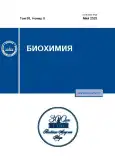Prediction of adverse effects of drug-drug interactions on the cardiovascular system based on the analysis of structure-activity relationships
- Authors: Sukhachev V.S1, Ivanov S.M1, Dmitriev A.V1
-
Affiliations:
- Institute of Biomedical Chemistry
- Issue: Vol 88, No 5 (2023)
- Pages: 773-784
- Section: Articles
- URL: https://journals.rcsi.science/0320-9725/article/view/144672
- DOI: https://doi.org/10.31857/S0320972523050068
- EDN: https://elibrary.ru/AXVAFQ
- ID: 144672
Cite item
Full Text
Abstract
Keywords
About the authors
V. S Sukhachev
Institute of Biomedical Chemistry
Email: withstanding@yandex.ru
119121 Moscow, Russia
S. M Ivanov
Institute of Biomedical Chemistry
Email: withstanding@yandex.ru
119121 Moscow, Russia
A. V Dmitriev
Institute of Biomedical Chemistry
Email: withstanding@yandex.ru
119121 Moscow, Russia
References
- Rekić, D., Reynolds, K. S., Zhao, P., Zhang, L., Yoshida, K., Sachar, M., Piquette, M. M., Huang, S. M., and Zineh, I. (2017) Clinical drug-drug interaction evaluations to inform drug use and enable drug access, J. Pharm. Sci., 106, 2214-2218, doi: 10.1016/j.xphs.2017.04.016.
- Carpenter, M., Berry, H., and Pelletier, A. L. (2019) Clinically relevant drug-drug interactions in primary care, Am. Fam. Physician, 99, 558-564.
- Kim, J., and Parish, A. L. (2017) Polypharmacy and medication management in older adults, Nurs. Clin. North. Am., 52, 457-468, doi: 10.1016/j.cnur.2017.04.007.
- Triaridis, S., Tsiropoulos, G., Rachovitsas, D., Psillas, G., and Vital, V. (2009) Spontaneous haematoma of the pharynx due to a rare drug interaction, Hippokratia, 13, 175-177.
- Костылева М. Н., Строк А. Б., Постников С. С., Грацианская А. Н., Ермилин А. E. (2022) Фармакотерапия в многопрофильном педиатрическом стационаре: полипрагмазия и риск лекарственных взаимодействий на примере клинического случая, Безопасность и риск фармакотерапии, 10, 302-314, doi: 10.30895/2312-7821-2022-10-3-302-314.
- Ключников С. О. (2014) Полипрагмазия: пути решения проблемы, Детские инфекции, 13, 36-41, doi: 10.22627/2072-8107-2014-13-4-36-41.
- Ivanov, S., Lagunin, A., Filimonov, D., and Poroikov, V. (2019) Assessment of the cardiovascular adverse effects of drug-drug interactions through a combined analysis of spontaneous reports and predicted drug-target interactions, PLoS Comput. Biol., 15, e1006851, doi: 10.1371/journal.pcbi.1006851.
- Зырянов С. К., Затолочина К. Э., Казаков А. С. (2022) Актуальные вопросы обеспечения безопасности пациентов: роль фармаконадзора, Общественное здоровье, 2, 25-34, doi: 10.21045/2782-1676-2021-2-3-25-34.
- Noguchi, Y., Tachi, T., and Teramachi, H. (2020) Comparison of Signal detection algorithms based on frequency statistical model for drug-drug interaction using spontaneous reporting systems, Pharm. Res., 37, 86, doi: 10.1007/s11095-020-02801-3.
- Казаков А. С., Лепахин В. К., Астахова А. В. (2013) Осложнения фармакотерапии, связанные с взаимодействием лекарственных средств, Рос. мед. биол. вестн. им. акад. И.П. Павлова, 21, 70-76, doi: 10.17816/pavlovj2013370-76.
- Chen, Z., Elizabeth, R., Lin, L., Nicole, P., and Jiuyong, L. (2020) Detecting high-quality signals of adverse drug-drug interactions from spontaneous reporting data, JBI, 112, 103603, doi: 10.1016/j.jbi.2020.103603.
- Strandell, J., Bate, A., Lindquist, M., and Edwards, I. R. (2008) Drug-drug interactions - a preventable patient safety issue? Br. J. Clin. Pharmacol., 65, 144-146, doi: 10.1111/j.1365-2125.2007.02981.x.
- Taguchi, Y., and Turki, T. (2021) Novel method for the prediction of drug-drug interaction based on gene expression profiles, Eur. J Pharm. Sci., 160, 105742, doi: 10.1016/j.ejps.2021.105742.
- Huang, J., Niu, C., Green, C. D., Yang, L., Mei, H., and Han, J. D. (2013) Systematic prediction of pharmacodynamic drug-drug interactions through protein-protein-interaction network, PLoS Comput. Biol., 9, e1002998, doi: 10.1371/journal.pcbi.1002998.
- Varma, M. V., Pang, K. S., Isoherranen, N., and Zhao, P. (2015) Dealing with the complex drug-drug Interactions: towards mechanistic models, Biopharm. Drug Dispos., 36, 71-92, doi: 10.1002/bdd.1934.
- Kastrin, A., Ferk, P., and Leskošek, B. (2018) Predicting potential drug-drug interactions on topological and semantic similarity features using statistical learning, PLoS One, 13, e0196865, doi: 10.1371/journal.pone.0196865.
- Shankar, S., Bhandari, I., Okou, D. T., Srinivasa, G., and Athri, P. (2021) Predicting adverse drug reactions of two-drug combinations using structural and transcriptomic drug representations to train an artificial neural network, Chem. Biol. Drug. Des., 97, 665-673, doi: 10.1111/cbdd.13802.
- Wishart, D. S., Feunang, Y. D., Guo, A. C., Lo, E. J., Marcu, A., Grant, J. R., Sajed, T., Johnson, D., Li, C., Sayeeda, Z., Assempour, N., Iynkkaran, I., Liu, Y., Maciejewski, A., Gale, N., Wilson, A., Chin, L., Cummings, R., Le, D., Pon, A., Knox, C., and Wilson, M. (2018) DrugBank 5.0: A major update to the DrugBank database for 2018, Nucleic Acids Res., 46, D1074-D1082, doi: 10.1093/nar/gkx1037.
- Tatonetti, N. P., Ye, P. P., Daneshjou, R., and Altman, R. B. (2012) Data-driven prediction of drug effects and interactions, Sci. Transl. Med., 4, 125, doi: 10.1126/scitranslmed.3003377.
- Hazell, L., and Shakir, S. A. W. (2006) Under-reporting of adverse drug reactions: a systematic review, Drug Saf., 29, 385-396, doi: 10.2165/00002018-200629050-00003.
- Filimonov, D. A, and Poroikov, V. V. (2008) Probabilistic Approaches in Activity Prediction. Chemoinformatics Approaches to Virtual Screening, RSC Publishing, Cambridge, pp. 182-216, doi: 10.1039/9781847558879-00182.
- Dmitriev, A., Filimonov, D., Lagunin, A., Karasev, D., Pogodin, P., Rudik, A., and Poroikov, V. (2019) Prediction of severity of drug-drug interactions caused by enzyme inhibition and activation, Molecules, 24, E3955, doi: 10.3390/molecules24213955.
- Filimonov, D., Poroikov, V., Borodina, Y., and Gloriozova, T. (1999) Chemical similarity assessment through multilevel neighborhoods of atoms: definition and comparison with the other descriptors, J. Chem. Inf. Comput. Sci., 39, 666-670, doi: 10.1021/ci980335o.
- Breiman, L. (2001) Random forests, Mach. Learn., 45, 5-32, doi: 10.1023/A:1010933404324.
- Wright, M. N., and Ziegler, A. (2017) Ranger: a fast implementation of Random Forests for high dimensional data in C++ and R, J. Stat. Softw., 77, 1-17, doi: 10.18637/jss.v077.i01.
- Sing, T., Sander, O., Beerenwinkel, N., and Lengauer, T. (2005) ROCR: visualizing classifier performance in R, Bioinformatics, 21, 3940-3941, doi: 10.1093/bioinformatics/bti623.
- Witchel, H. J., Hancox, J. C., and Nutt, D. J. (2003) Psychotropic drugs, cardiac arrhythmia, and sudden death, J. Clin. Psychopharmacol., 23, 58-77, doi: 10.1097/00004714-200302000-00010.
- Liu, R., AbdulHameed, M. D. M., Kumar, K., Yu, X., Wallqvist, A., and Reifman, J. (2017) Data-driven prediction of adverse drug reactions induced by drug-drug interactions, BMC Pharmacol. Toxicol., 18, 44, doi: 10.1186/s40360-017-0153-6.
Supplementary files










